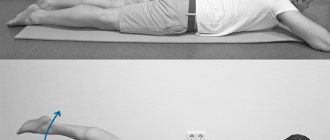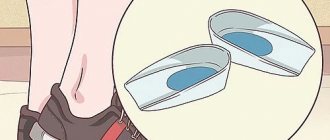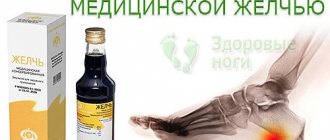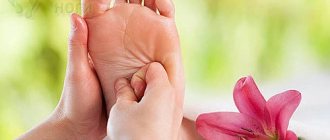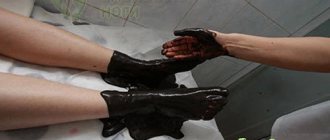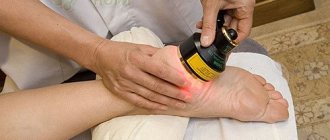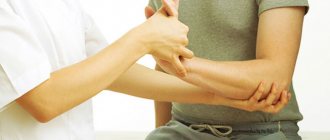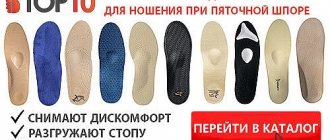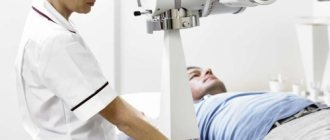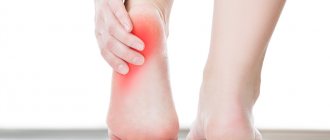For inflammation of the fascia and bone growth on the heel, doctors, in addition to medicinal treatment methods, recommend heel massage for heel spurs.
The best option is when the procedure is performed by a professional massage therapist or chiropractor.
However, not all patients have the opportunity to visit these specialists every day.
In this case, you can perform self-massage for heel spurs yourself, knowing the basic rules and techniques for its implementation.
How does massage help with heel spurs?
Massage treatment for plantar fasciitis is part of a comprehensive treatment program and goes well with both conservative medicine and folk recipes for the treatment of heel spurs.
A correctly performed procedure has the following positive effects:
- increases blood supply to the affected fascia;
- launches tissue regeneration processes;
- eliminates swelling and stiffness of the foot muscles;
- strengthens the ligaments and muscles of the foot;
- relieves tension and pain;
- promotes better absorption of local medications.
To see improvements in the patient’s condition, 10-20 massage sessions are necessary. Before carrying out the procedure, be sure to consult with an orthopedist and make sure there are no contraindications.
If you are undergoing physical therapy for a heel spur, ask your physical therapist about the impact of massage on the healing process.
Attention! Massage aimed at crushing and eliminating bone growth, including intense impact, can only be performed by a specialist.
How to massage a heel spur?
As a rule, self-massage is used by patients to relieve pain and strengthen the ligaments of the feet. In this case, it is better to carry out the procedure in the evening after a set of gymnastic exercises for heel spurs.
Before the massage, it is recommended to steam your feet in a foot bath with salt, honey, clay or bioshift.
To enhance the effect of self-massage, you can use warming ointments instead of oil or massage gel:
- Voltaren;
- Fastum-gel;
- Nayatoks;
- Capsicam, etc.
The Pyatkashpor cream, created specifically to eliminate growths and soften the skin on the legs, increases the effectiveness of the massage. The cream is quickly absorbed and resolves the spur, relieves swelling, helping to reduce pain.
Before you begin directly massaging the sore heel, you need to warm up and prepare the muscles of the lower leg and feet. To do this, you need to rub them with your hands from bottom to top. To enhance the effect, you can use a massage mitten.
TOP 5 best self-massage techniques
- Small pinches with fingers. From the longitudinal arch of the foot, make small pinches with your fingertips towards the bone growth.
- Rubbing with fingertips. With maximum effort, rub your heel in different directions: up/down, left/right.
- Intensive circular rubbing. Start rubbing the heel from the edges, gradually concentrating around the spike.
- Impact on the spur. Grasp your heel with your hands so that your thumbs are on top and gently massage the heel spike.
- Rib strikes. Apply light strikes with the edge of your palm up and down.
Please note that you will experience severe pain when pressing on the spur. The intensity of the massage movements should cause moderate pain, but in no case severe.
The massage techniques described above should be repeated 2-3 times. To finish the massage for heel spurs at home, you need to rub and generally stroke the foot.
At the end of the procedure, you can reapply Pyatkaspor ointment and put on a Strasbourg night sock for maximum restoration of relaxed fascia.
Reflex zones, their stimulation
The surface of the feet, like the palms, contains receptors, nerve endings through which information flows to the brain, as well as internal organs. The branch of medicine that specializes in the study of areas of reflexes in the body is called reflexology.
Taking care of your feet conveys a comfortable, healthy state to the body. But there is also a reverse connection: disruption in the functioning of internal organs is also reflected on the surface of the skin. Knowing and focusing on the signal output points, you can engage in not only diagnostics, but also treatment.
Reflexology is used for diagnostic and therapeutic purposes. There are 36 zones on each sole. The foot projects the human body, where the heel is the knees and pelvic area, and the toes are the projection of the head.
At the top there are points that are responsible for the brain, hearing, vision, and pituitary gland. The wide area of the heel is connected to the heart muscle, liver, and lungs. The lower part of the foot affects the genitals, intestinal system, and kidneys. The projection of the spinal column is the lateral inner surface of the foot.
In Eastern medicine, considerable importance is also paid to foot stimulation and communication at the energetic level.
Massage mat and massager for heel spurs
Orthopedic doctors and chiropractors, when telling how to treat heel spurs at home, advise using special devices - massage mats and massagers.
Massage mats
The most useful are silicone products with separated massage zones. Such mats not only help reduce the pain of spurs, but also help eliminate the main cause of fasciitis - flat feet. Using zone mats is very simple: you need to stand on them and imitate walking, stepping into different zones for 10-15 minutes.
Regular massage with a mat can improve blood circulation, relieve tired legs, and remove swelling. When exposed to the points of the foot, the nerve endings compressed by the growth are released and pain is reduced. If you are looking for a way to quickly relieve pain from a heel spur, then such a mat will be a real find. You can buy massage mats on our website.
Massagers
The most popular are roller hand massagers and hardware vibrating foot massagers. Under the influence of vibration, the fascia relaxes and the heel spike is gently massaged. As a result, the patient starts regeneration and eliminates muscle stiffness.
When using a vibrating massager, it is important to monitor the intensity of vibration - it should cause minimal discomfort, but not severe pain. In terms of effectiveness, vibrating massagers and roller massagers are comparable to some physical procedures.
Massaging heel spurs with a massager helps strengthen the fascia, ligaments and tendons of the feet. This leads not only to pain relief, but also prevents the growth of the thorn.
Diagnostics
For diagnosis, you need to contact an orthopedist or surgeon. He needs to describe the pain and other symptoms, tell how long ago they appeared, what features they have (for example, the pain intensifies in the morning or after a long rest). During the interview and examination, the doctor may ask about the nature of the work (how much time you have to spend on your feet), about physical activity, and about what kind of shoes the patient usually wears. It is important that the doctor determines why the formation and growth of the heel spur occurred - treatment will depend on this. During the examination, the doctor may palpate the foot. Due to the growth, there may be a feeling of discomfort or pain when palpating or pressing on the heel. It can become worse if you increase the tension on the fascia by pulling your toe toward you or extending your big toe. Sometimes there is slight swelling on the heel.
During diagnosis, additional studies are carried out:
- X-ray to identify a bone growth, to rule out a fracture if there was an injury. If the heel spur has recently started to form, it may not be visible on the photo.
- MRI is used to assess the condition of soft tissues and ligaments. It is rarely prescribed if there are unusual symptoms or there is a possibility that the plantar fascia has been torn.
- Ultrasound is used if you need to monitor the progress of treatment.
- Duplex scanning of the vessels of the lower extremities is prescribed if there are signs of circulatory disorders.
- Clinical, biochemical blood tests are carried out to diagnose inflammation and if there is a suspicion of gout (chronic inflammation of the joints).
Heel pain is not always associated with the formation of a bone spur. The foot can hurt for other reasons. When diagnosing, you need to exclude:
- injuries, bruises, fractures;
- tibial nerve neuropathy, other neurological diseases;
- rheumatoid arthritis;
- bursitis;
- inflammation of bone tissue;
- gout and other diseases.
Sometimes the pain is associated with the condition of the muscles of the plantar part of the foot. If painful, compacted areas appear on them, the pain can be very similar to that which occurs when a bone spur forms: they are also localized in the heel area and intensify with load.
What to combine with foot massage for heel spurs?
Self-massage will not help cure fasciitis unless it is carried out in combination with other therapeutic techniques:
- Drug treatment in the form of tablets, ointments with anti-inflammatory effects.
- Physiotherapeutic procedures aimed at reducing spurs and relieving symptoms.
- Full relief of the heels with the help of orthopedic insoles, Strutz arch supports and heel pads.
When choosing insoles, it is necessary to take into account the nature of the spur, the presence of accompanying foot deformities and the characteristics of sweating.
We have made for you a review of the 10 best insoles for spurs, after studying which you can choose the optimal orthopedic devices for street, sports and indoor shoes.
In addition to insoles, you can use silicone heel pads to cushion and protect the damaged heel.
Here is a selection of the 5 best lifters that will help consolidate the effect of the massage and cure fasciitis.
Benefits for the child
Massage helps a child in the following cases:
- To reduce the risk of orthopedic diseases.
- Strengthen the musculoskeletal system.
- Correctly form the arch of the foot.
- Normalize muscle tone.
You can perform a massage procedure on your child yourself, in consultation with a pediatrician and physiotherapist.
Rules for self-massage
Before starting massage treatment, read the rules and recommendations of specialists, the implementation of which will help you avoid mistakes and side effects:
- For improvements to occur, self-massage must be done regularly. The optimal mode is daily in the evening.
- Increase the force of impact gradually.
- Massage the hard areas around the spur with maximum pressure, which causes tolerable pain.
- After the session, it is mandatory to use a Strasbourg sock. At this time, the fascia is relaxed and stretched; it is important to fix it in this position throughout the night.
- If the pain intensifies after the procedure, then next time reduce the intensity and pace.
Attention! You cannot use such barbaric methods of “massage” as hitting with a rolling pin and other objects. Such techniques can be found in magazines and on the Internet; their use often leads to foot injuries.
Is it always possible to massage a heel spur? Contraindications
As with other procedures, self-massage has a number of contraindications:
- open and purulent wounds on the feet;
- undergoing a course of radiotherapy;
- neoplasms on the legs;
- problems with blood supply to the extremities;
- tuberculosis.
After complete cure of fasciitis, it is recommended to perform manual massage or use a massage mat 1-2 times a week to prevent recurrence of bone growth.
Features of the procedure
The heel is one of the most important bones of the human skeleton. It was not for nothing that in the Middle Ages in Eastern countries they carried out torture by sewing horsehair into the heels - this brought hellish, martyrdom pain. Therefore, it is very important to take care of your feet and massage your heels regularly. It is recommended to massage while sitting on a chair or lying on your back. Today, there are a huge number of massage mats with a variety of coatings on store shelves, but massaging the feet with your hands remains the most effective. In addition to traditional heel massage, rubbing and pinching are often used.
